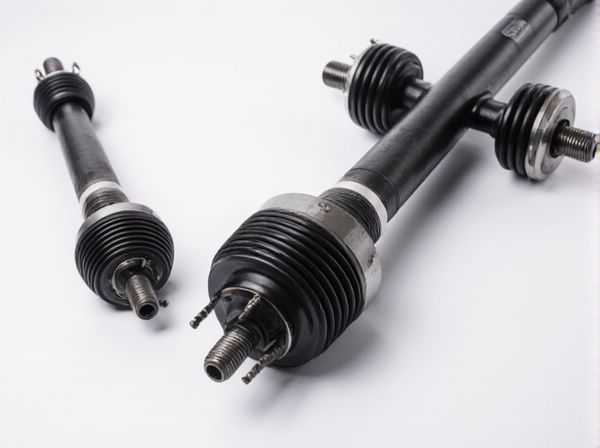
Photo illustration: Solid Axle vs Independent Axle
Solid axles provide superior durability and load-bearing capacity, making them ideal for heavy-duty and off-road vehicles. Independent axles offer enhanced ride comfort and improved handling by allowing each wheel to move independently over uneven terrain. Your choice should balance the need for ruggedness with the desire for a smoother driving experience.
Table of Comparison
| Feature | Solid Axle | Independent Axle |
|---|---|---|
| Design | Single rigid shaft connecting both wheels | Each wheel moves independently |
| Suspension | Less flexible, moves as a unit | More flexible, better wheel articulation |
| Ride Comfort | Lower, transmits more road shocks | Higher, isolates road irregularities |
| Durability | Robust, suitable for heavy loads | Less durable under heavy stress |
| Handling | Reduced, less responsive in turns | Improved steering and cornering control |
| Cost | Lower manufacturing and maintenance cost | Higher cost due to complexity |
| Application | Trucks, off-road, heavy-duty vehicles | Passenger cars, sports cars, SUVs |
Introduction to Axle Types
Solid axle, also known as a live axle, connects both wheels on an axle housing, providing strength and durability ideal for heavy-duty and off-road vehicles. Independent axle allows each wheel to move independently, enhancing ride comfort and handling, commonly used in passenger cars and light trucks. Understanding these fundamental differences helps in selecting the right axle type for specific vehicle performance and terrain requirements.
What is a Solid Axle?
A solid axle, also known as a beam axle, is a single rigid shaft connecting the wheels on opposite sides of a vehicle, allowing both wheels to move together as one unit. This design offers enhanced durability and load-bearing capacity, making it ideal for heavy-duty trucks, off-road vehicles, and rear-wheel-drive setups. Solid axles provide better articulation and strength in rough terrain but typically result in a harsher ride and less precise handling compared to independent axle systems.
Understanding Independent Axles
Independent axles allow each wheel to move vertically without affecting the opposite wheel, enhancing ride comfort and handling on uneven terrain. This design improves traction and stability by enabling better tire contact with the ground during cornering and off-road conditions. Independent suspension systems commonly utilize components like control arms, coil springs, and shock absorbers to absorb road shocks efficiently.
Key Differences Between Solid and Independent Axles
Solid axles feature a single rigid beam connecting both wheels, delivering uniform wheel alignment and enhanced durability, which makes them ideal for heavy-duty vehicles and off-road use. Independent axles allow each wheel to move independently, improving ride comfort, handling, and traction on uneven terrain, commonly found in passenger cars and SUVs. The main differences include ride quality, suspension complexity, weight distribution, and maintenance demands, with solid axles offering simplicity and strength, while independent axles prioritize performance and flexibility.
Performance Comparison: On-Road vs Off-Road
Solid axles excel in off-road performance due to their superior durability and consistent ground clearance, providing better traction on uneven terrains and obstacles. Independent axles enhance on-road handling and ride comfort with improved wheel articulation and reduced unsprung weight, leading to better stability and smoother cornering. The choice between solid and independent axles depends on whether off-road ruggedness or on-road driving refinement is prioritized.
Ride Comfort and Handling Characteristics
Solid axles provide robust durability and excellent off-road traction but typically result in a harsher ride and less precise handling due to the interconnected wheel movement. Independent axles enhance ride comfort by allowing each wheel to respond individually to road irregularities, significantly improving handling and stability on various terrains. Vehicles equipped with independent suspension systems benefit from reduced unsprung weight, promoting better traction and smoother driving experiences.
Durability and Maintenance Requirements
Solid axle systems provide superior durability in heavy-duty and off-road applications due to their robust, unified structure that withstands intense stress and rough terrain. Independent axle setups offer easier maintenance and better adaptability for routine servicing as each wheel operates separately, reducing wear on suspension components. While solid axles demand less frequent repairs, independent axles require more consistent attention to bushings and joints to maintain performance.
Cost Analysis: Installation and Upkeep
Solid axles generally offer lower installation costs due to their simpler design and fewer moving parts compared to independent axles. Maintenance expenses for solid axles tend to be less frequent and less complex, as they typically require fewer components like CV joints or constant velocity boots found in independent suspensions. Independent axles, while providing superior ride comfort and handling, often incur higher upkeep costs due to increased part wear and the need for more precise alignment and regular inspections.
Application Suitability: Cars, Trucks, and SUVs
Solid axles offer superior durability and load-bearing capacity, making them ideal for trucks and heavy-duty SUVs used in off-road or towing applications. Independent axles provide enhanced ride comfort and improved handling, which suits passenger cars and light SUVs designed primarily for on-road driving. Vehicle manufacturers select axle types based on performance requirements, balancing ruggedness and maneuverability for specific applications.
Choosing the Right Axle for Your Vehicle
Choosing the right axle for your vehicle depends on factors like terrain type, load capacity, and ride comfort preferences. Solid axles offer durability and superior load-bearing for off-road and heavy-duty applications, while independent axles enhance ride quality and handling on paved roads by allowing each wheel to move independently. Assessing vehicle use, such as off-roading or daily commuting, ensures optimal performance and longevity with the selected axle type.
 caratoz.com
caratoz.com